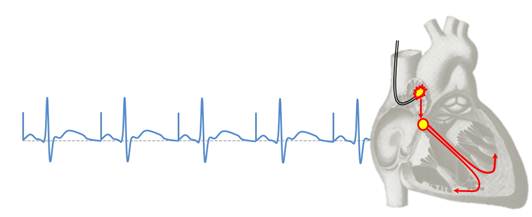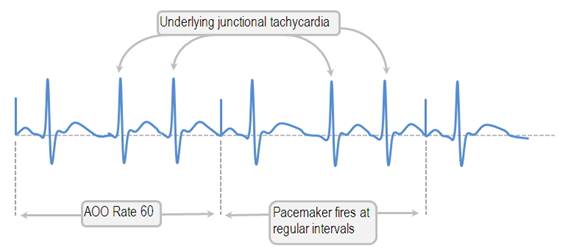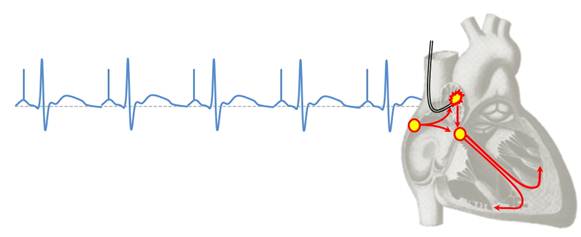The atrial pacemaker will show a rhythm with paced “spikes”,
just in front of the P waves. Patients with sick sinus syndrome
and normal atrioventricular conduction, pacing can be accomplished
with either a single chamber atrial pacemaker AAI/R or a dual
chamber pacemaker DDD/R. The single chamber device has the advantages
of simpler implantation and lower initial costs, while the dual
chamber device offers protection in case atrioventricular conduction
disturbances develop in the future. Here we will be looking at
single chamber atrial pacing (A Paced)
Single chamber pacing modes
With atrial single chamber, you only have a choice of AAI or AOO.
The ventricular single chamber you have VOO or VVI. Triggered modes
such as AAT and VVT are also available.
Single-chamber atrial pacing
Single chamber atrial pacemakers are used in the presence of AV conduction disorders.
Here the atrium might do its job, but the ventricle will not -and your ventricular
rate will still be a slow "native" ventricular rhythm. Atrial pacing in general doesn't
tend to work in the presence of atrial fibrillation, particularly if this is chronic.
A huge dilated atrium with useless conduction fibers will have no better luck coordinating
with the pacemaker than it did with the sinoatrial node.
AOO - asynchronous atrial pacing
Asynchronous atrial pacing mode is usually the programmed response of an AAI pacemaker to the
application of a magnet. This is never a permanent mode. In general, it is said that asynchronous
pacing is contraindicated in the presence of intrinsic cardiac rhythms.

The above diagram illustrates AOO pacing with a sufficiently rapid rate, and 1:1 capture.
Essentially, this mode takes advantage of an intact AV node and other conducting pathways.
The SA node will probably also try to fire, but with a sufficiently rapid atrial rate the
SA node's orders will fall upon the deaf ears of an atrium in its refractory period.
This mode is totally asynchronous. If the rate is not high enough, you will have an
underlying rhythm competing with the pacemaker.
AAI - atrial demand pacing
In AAI the atrium is sensed as well as paced. There is no reaction if the atrium fires normally-
the pacemaker listens for normal atrial activity, and does not interfere with it. However,
if the atrial activity is occurring at a rate slower than the set pacemaker rate, the pacemaker
will step in and fire.

Again, this mode is relying on normal AV conduction. In a person with a normal AV node and
reasonably normal atrium, the AAI pacemaker will guarantee a certain rate.
AAT - atrial pacing
This weird pacing mode will only pace whenever the atrium contracts. This seems counter intuitive;
the atrium is clearly producing some valid electrical signals- why would you want to "pace along"?
Well. This mode, as I have discovered from A Practical Guide to Cardiac Pacing by Moses and Mullin,
is of purely historical interest.


The pacing spikes in properly sensing AAT are above every P wave. This, in the distant past, was useful.
The cardiac physiologist would program the pacemaker to pace in AAT to check its sensitivity -
to see whether all the atrial activity was being sensed. If half the P waves did not merit a pacing spike,
clearly the pacemaker was not sensitive enough. Conversely, an oversensitive pacemaker would mistake all
sorts of noise for an atrial contraction, and pacing spikes would appear all over the place.
These days, the equipment and methods are sufficiently advanced that this mode has become a museum artifact.
For most people, it is completely useless to sense and then pace the same chamber.
|




